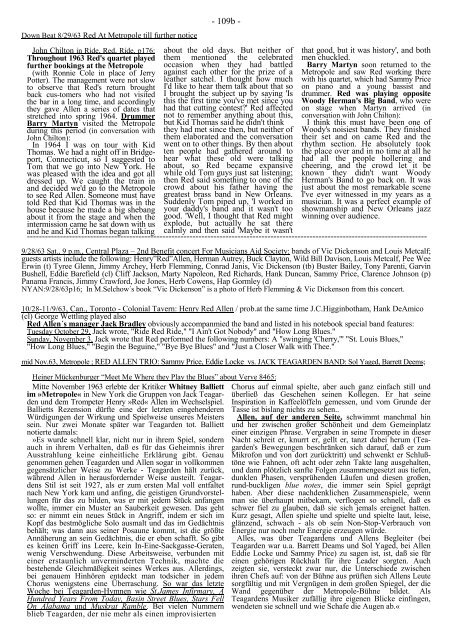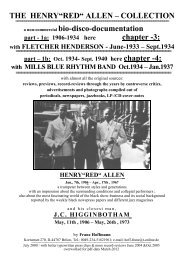Red Allen Chapters 9 - The Jazz Archive
Red Allen Chapters 9 - The Jazz Archive
Red Allen Chapters 9 - The Jazz Archive
Create successful ePaper yourself
Turn your PDF publications into a flip-book with our unique Google optimized e-Paper software.
Down Beat 8/29/63 <strong>Red</strong> At Metropole till further notice<br />
John Chilton in Ride, <strong>Red</strong>, Ride, p176:<br />
Throughout 1963 <strong>Red</strong>'s quartet played<br />
further bookings at the Metropole<br />
(with Ronnie Cole in place of Jerry<br />
Potter). <strong>The</strong> management were not slow<br />
to observe that <strong>Red</strong>'s return brought<br />
back cus-tomers who had not visited<br />
the bar in a long time, and accordingly<br />
they gave <strong>Allen</strong> a series of dates that<br />
stretched into spring 1964. Drummer<br />
Barry Martyn visited the Metropole<br />
during this period (in conversation with<br />
John Chilton):<br />
In 1964 I was on tour with Kid<br />
Thomas. We had a night off in Bridgeport,<br />
Connecticut, so I suggested to<br />
Tom that we go into New York. He<br />
was pleased with the idea and got all<br />
dressed up. We caught the train in<br />
and decided we'd go to the Metropole<br />
to see <strong>Red</strong> <strong>Allen</strong>. Someone must have<br />
told <strong>Red</strong> that Kid Thomas was in the<br />
house because he made a big shebang<br />
about it from the stage and when the<br />
intermission came he sat down with us<br />
and he and Kid Thomas began talking<br />
- 109b -<br />
about the old days. But neither of<br />
them mentioned the celebrated<br />
occasion when they had battled<br />
against each other for the prize of a<br />
leather satchel. I thought how much<br />
I'd like to hear them talk about that so<br />
I brought the subject up by saying 'Is<br />
this the first time you've met since you<br />
had that cutting contest?' <strong>Red</strong> affected<br />
not to remember anything about this,<br />
but Kid Thomas said he didn't think<br />
they had met since then, but neither of<br />
them elaborated and the conversation<br />
went on to other things. By then about<br />
ten people had gathered around to<br />
hear what these old were talking<br />
about, so <strong>Red</strong> became expansive<br />
while old Tom guys just sat listening;<br />
then <strong>Red</strong> said something to one of the<br />
crowd about his father having the<br />
greatest brass band in New Orleans.<br />
Suddenly Tom piped up, 'I worked in<br />
your daddy's band and it wasn't too<br />
good. 'Well, I thought that <strong>Red</strong> might<br />
explode, but actually he sat there<br />
calmly and then said 'Maybe it wasn't<br />
that good, but it was history', and both<br />
men chuckled.<br />
Barry Martyn soon returned to the<br />
Metropole and saw <strong>Red</strong> working there<br />
with his quartet, which had Sammy Price<br />
on piano and a young bassist and<br />
drummer. <strong>Red</strong> was playing opposite<br />
Woody Herman's Big Band, who were<br />
on stage when Martyn arrived (in<br />
conversation with John Chilton):<br />
I think this must have been one of<br />
Woody's noisiest bands. <strong>The</strong>y finished<br />
their set and on came <strong>Red</strong> and the<br />
rhythm section. He absolutely took<br />
the place over and in no time at all he<br />
had all the people hollering and<br />
cheering, and the crowd let it be<br />
known they didn't want Woody<br />
Herman's Band to go back on. It was<br />
just about the most remarkable scene<br />
I've ever witnessed in my years as a<br />
musician. It was a perfect example of<br />
showmanship and New Orleans jazz<br />
winning over audience.<br />
-------------------------------------------------------------------------------------------------------------------------------------<br />
9/28/63 Sat., 9 p.m., Central Plaza – 2nd Benefit concert For Musicians Aid Society: bands of Vic Dickenson and Louis Metcalf;<br />
guests artists include the following: Henry”<strong>Red</strong>”<strong>Allen</strong>, Herman Autrey, Buck Clayton, Wild Bill Davison, Louis Metcalf, Pee Wee<br />
Erwin (t) Tyree Glenn, Jimmy Archey, Herb Flemming, Conrad Janis, Vic Dickenson (tb) Buster Bailey, Tony Parenti, Garvin<br />
Bushell, Eddie Barefield (cl) Cliff Jackson, Marty Napoleon, <strong>Red</strong> Richards, Hank Duncan, Sammy Price, Clarence Johnson (p)<br />
Panama Francis, Jimmy Crawford, Joe Jones, Herb Cowens, Hap Gormley (d)<br />
NYAN:9/28/63p16; In M.Selchow´s book “Vic Dickenson” is a photo of Herb Flemming & Vic Dickenson from this concert.<br />
10/28-11/9/63, Can., Toronto - Colonial Tavern: Henry <strong>Red</strong> <strong>Allen</strong> / prob.at the same time J.C.Higginbotham, Hank DeAmico<br />
(cl) George Wettling played also<br />
<strong>Red</strong> <strong>Allen</strong>´s manager Jack Bradley obviously accompanmied the band and listed in his notebook special band features:<br />
Tuesday October 29, Jack wrote, "Ride <strong>Red</strong> Ride," "I Ain't Got Nobody" and "How Long Blues."<br />
Sunday, November 3, Jack wrote that <strong>Red</strong> performed the following numbers: A "swinging 'Cherry,'" "St. Louis Blues,"<br />
"How Long Blues," "Begin the Beguine," "Bye Bye Blues" and "Just a Closer Walk with <strong>The</strong>e."<br />
mid Nov.63, Metropole ; RED ALLEN TRIO: Sammy Price, Eddie Locke vs. JACK TEAGARDEN BAND: Sol Yaged, Barrett Deems;<br />
Heiner Mückenburger “Meet Me Where they Play the Blues” about Verve 8465:<br />
Mitte November 1963 erlebte der Kritiker Whitney Balliett<br />
im »Metropole« in New York die Gruppen von Jack Teagarden<br />
und dem Trompeter Henry »<strong>Red</strong>« <strong>Allen</strong> im Wechselspiel.<br />
Ballietts Rezension dürfte eine der letzten eingehenderen<br />
Würdigungen der Wirkung und Spielweise unseres Meisters<br />
sein. Nur zwei Monate später war Teagarden tot. Balliett<br />
notierte damals:<br />
»Es wurde schnell klar, nicht nur in ihrem Spiel, sondern<br />
auch in ihrem Verhalten, daß es für das Geheimnis ihrer<br />
Ausstrahlung keine einheitliche Erklärung gibt. Genau<br />
genommen gehen Teagarden und <strong>Allen</strong> sogar in vollkommen<br />
gegensätzlicher Weise zu Werke - Teagarden hält zurück,<br />
während <strong>Allen</strong> in herausfordernder Weise austeilt. Teagardens<br />
Stil ist seit 1927, als er zum ersten Mal voll entfaltet<br />
nach New York kam und anfing, die geistigen Grundvorstellungen<br />
für das zu bilden, was er mit jedem Stück anfangen<br />
wollte, immer ein Muster an Sauberkeit gewesen. Das geht<br />
so: er nimmt ein neues Stück in Angriff, indem er sich im<br />
Kopf das bestmögliche Solo ausmalt und das im Gedächtnis<br />
behält; was dann aus seiner Posaune kommt, ist die größte<br />
Annäherung an sein Gedächtnis, die er eben schafft. So gibt<br />
es keinen Griff ins Leere, kein In-Eine-Sackgasse-Geraten,<br />
wenig Verschwendung. Diese Arbeitsweise, verbunden mit<br />
einer erstaunlich unverminderten Technik, machte die<br />
bestehende Gleichmäßigkeit seines Werkes aus. Allerdings,<br />
bei genauem Hinhören entdeckt man todsicher in jedem<br />
Chorus wenigstens eine Überraschung. So war das letzte<br />
Woche bei Teagarden-Hymnen wie St.James Infirmary, A<br />
Hundred Years From Today, Basin Street Blues, Stars Fell<br />
On Alabama und Muskrat Ramble. Bei vielen Nummern<br />
blieb Teagarden, der nie mehr als einen improvisierten<br />
Chorus auf einmal spielte, aber auch ganz einfach still und<br />
überließ das Geschehen seinen Kollegen. Er hat seine<br />
Inspiration in Kaffeelöffeln gemessen, und vom Grunde der<br />
Tasse ist bislang nichts zu sehen..<br />
<strong>Allen</strong>, auf der anderen Seite, schwimmt manchmal hin<br />
und her zwischen großer Schönheit und dem Gemeinplatz<br />
einer einzigen Phrase. Vergraben in seine Trompete in dieser<br />
Nacht schreit er, knurrt er, gellt er, tanzt dabei herum (Teagarden's<br />
Bewegungen beschränken sich darauf, daß er zum<br />
Mikrofon und von dort zurücktritt) und schwenkt er Schlußtöne<br />
wie Fahnen, oft acht oder zehn Takte lang ausgehalten,<br />
und dann plötzlich sanfte Folgen zusammengesetzt aus tiefen,<br />
dunklen Phasen, versprühenden Läufen und diesen großen,<br />
rund-buckligen blue notes, die immer sein Spiel geprägt<br />
haben. Aber diese nachdenklichen Zusammenspiele, wenn<br />
man sie überhaupt mitbekam, verflogen so schnell, daß es<br />
schwer fiel zu glauben, daß sie sich jemals ereignet hatten.<br />
Kurz gesagt, <strong>Allen</strong> spielte und spielte und spielte laut, leise,<br />
glänzend, schwach - als ob sein Non-Stop-Verbrauch von<br />
Energie nur noch mehr Energie erzeugen würde.<br />
Alles, was über Teagardens und <strong>Allen</strong>s Begleiter (bei<br />
Teagarden war u.a. Barrett Deams und Sol Yaged, bei <strong>Allen</strong><br />
Eddie Locke und Sammy Price) zu sagen ist, ist, daß sie für<br />
einen gehörigen Rückhalt für ihre Leader sorgten. Auch<br />
zeigten sie, versteckt zwar nur, die Unterschiede zwischen<br />
ihren Chefs auf: von der Bühne aus prüften sich <strong>Allen</strong>s Leute<br />
sorgfältig und mit Vergnügen in dem großen Spiegel, der die<br />
Wand gegenüber der Metropole-Bühne bildet. Als<br />
Teagardens Musiker zufällig ihre eigenen Blicke einfingen,<br />
wendeten sie schnell und wie Schafe die Augen ab.«



